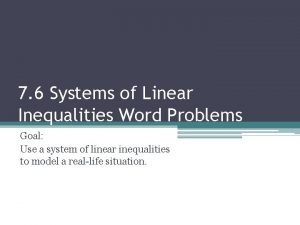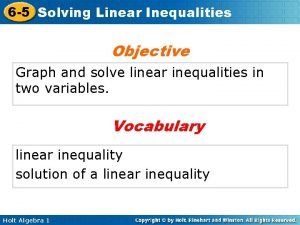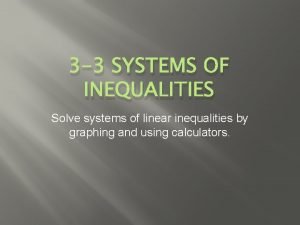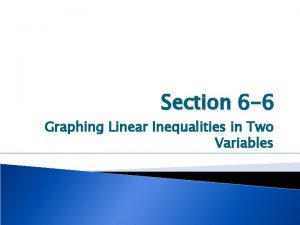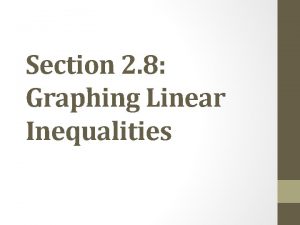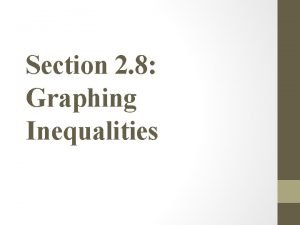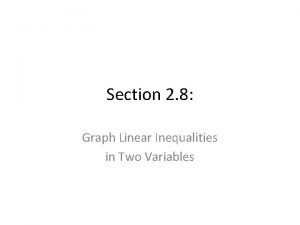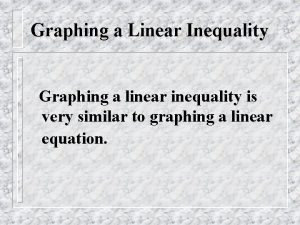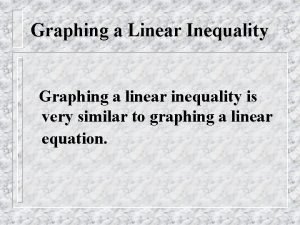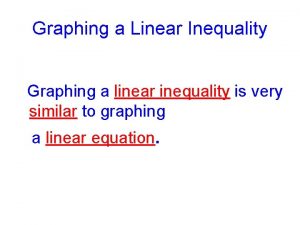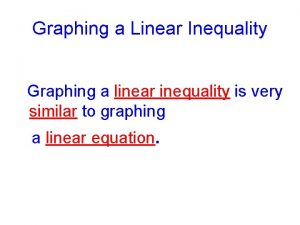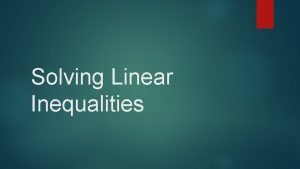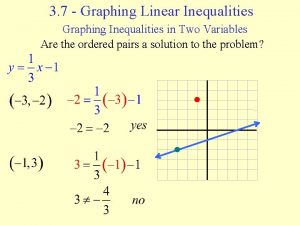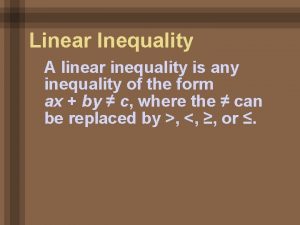Section 2 8 Graphing Inequalities A linear inequality








- Slides: 8

Section 2. 8: Graphing Inequalities

A linear inequality resembles a linear equation, but with an inequality instead of an equals symbol. For example, y > – 3 x – 2 versus y = – 3 x – 2. *The graph of the inequality y > – 3 x – 2 is shown at the right as a shaded region. *Every point in the shaded region satisfies the inequality. The graph of y = – 3 x – 2 is the boundary of the region. It is drawn as a dashed line to show that points on the line do not satisfy the inequality. If the symbol was ≤ or ≥, then the points on the boundary would satisfy the inequality, so the boundary would be written as a solid line.

Example 1: Graph x – 2 y < 4.

Example 2: One tutoring company advertises that it specializes in helping students who have a combined score on the SAT that is 900 or less. a) Write an inequality to describe the combined scores of students who are prospective tutoring clients. Let x represent the verbal score and y the math score. Graph the inequality. b) Does a student with verbal score of 480 and a math score of 410 fit the tutoring company’s guidelines?

Example 3: Two social studies classes are going on a field trip. The teachers have asked for parent volunteers to also go on the trip as chaperones. However, there is only enough seating for 60 people on the bus. a) What is an inequality to describe the number of students and chaperones that can ride on the bus? a) s + c ≥ 60 b) s + c ≤ 60 c) s + c < 60 d) s + c > 60

b) Can 15 chaperones and 47 students ride on the bus?

Graphing Absolute Value Inequalities *First graph the absolute value equation. *Second, determine whether the boundary line is dashed (when the symbols < or > are used) or solid (when the symbols ≤ or ≥ are used). *Last, determine which region should be shaded. (< and ≤, shade below the vertex, > and ≥, shade above the vertex. ) Example 4: Graph y ≥ |x| – 2.

Example 5: Which of the following is the graph of y < |x| + 3? a) c) b) d)
 Solving systems of linear inequalities by graphing
Solving systems of linear inequalities by graphing Linear inequality word problems worksheet
Linear inequality word problems worksheet Systems of inequalities quiz part one
Systems of inequalities quiz part one Graphing linear inequalities notes
Graphing linear inequalities notes Solve systems of linear inequalities by graphing calculator
Solve systems of linear inequalities by graphing calculator Graphing inequalities
Graphing inequalities 2-8 graphing linear inequalities
2-8 graphing linear inequalities 2-8 graphing linear inequalities
2-8 graphing linear inequalities 2-8 graphing linear inequalities
2-8 graphing linear inequalities

